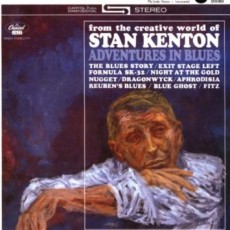
Daily Dose Of Jazz…
Stanley Newcomb Kenton was born on December 15, 1911 in Wichita, Kansas and was raised in Colorado, then in California. Conceived out of wedlock, his parents told everyone he was born on February 19, 1912 and believing this as fact well into adulthood, he recorded an album Birthday in Britain in 1973 and his grave marker even reflects this erroneous date.
Kenton learned piano as a child, influenced by Earl Hines, attending Bell High School, graduating in 1930 and while still a teenager toured with various bands. He played in the 1930s in the dance bands of Vido Musso and Gus Arnheim, but his natural inclination was as a bandleader.
In June 1941 he formed his own band, which developed into one of the best-known West Coast ensembles of the 1940s. It was later named Artistry in Rhythm after his theme song. In the mid-1940s, Kenton’s band and style became known as “The Wall of Sound”, a tag later used by Phil Spector.
Much more important in the early days as an arranger, Stan was an inspiration for his loyal sidemen in his first band such as Howard Rumsey and Chico Alvarez. Influenced by Jimmie Lunceford and his high note trumpeters and thick-toned tenors, the orchestra struggled after its initial success. Record sales were low and even being Bob Hope’s backup band was not a pleasant experience.
By 1942 Kenton was in New York City, the band was catching on with an endorsement by Fred Astaire on the Roseland Ballroom marquee. He had Art Pepper, Stan Getz, Boots Mussulli and Anita O’Day as part of the ensemble. Lyricist Joe Greene put words to the songs And Her Tears Flowed Like Wine and Don’t Let The Sun Catch You Cryin. Stan would bring in Pete Rugulo as his chief arranger along with Bob Cooper and June Christy. The band’s popularity increased with Christy hits Tampico and Across The Alley From The Alamo, and recorded the popular tune Laura, the song from the film.
Calling his music “progressive jazz,” Kenton sought to lead a concert orchestra as opposed to a dance band at a time when most big bands were starting to break up. Over the years he would employ Kai Winding, Buddy Childers, Ray Wetzel, Al Porcino, Jack Costanzo, Shorty Rogers, Shelly Manne, Bud Shank, Laurindo Almeida, Maynard Ferguson, Gerry Mulligan, Marty Paich, Bill Holman, Mel Lewis, Pete and Conte Candoli, Bill Perkins, Stan Levey, Lucky Thompson, Jack Sheldon, Frank Rosolino, Sam Noto, Carl Saunders, Lee Konitz, Chris Connor and the list goes on.
Kenton won Grammy awards in 1962 and 1963 for his Kenton’s West Side Story and Adventures In Jazz, respectively. He had several Top 40 hits, founded his own label, “The Creative World of Stan Kenton”, recording several live concerts. As an educator he encouraged big band music in high schools and colleges, instructing what he called progressive jazz, making available his charts to the bands. He donated his entire library to the music department of the University of North Texas and the Stan Kenton Jazz Recital hall is named in his honor.
Entering Midway Hospital on August 17, 1979 after suffering a stroke, pianist, arranger, composer, bandleader and educator Stan Kenton, who recorded over seven-dozen albums with an innovative and often controversial jazz orchestra, passed away on August 25, 1979.
More Posts: piano


